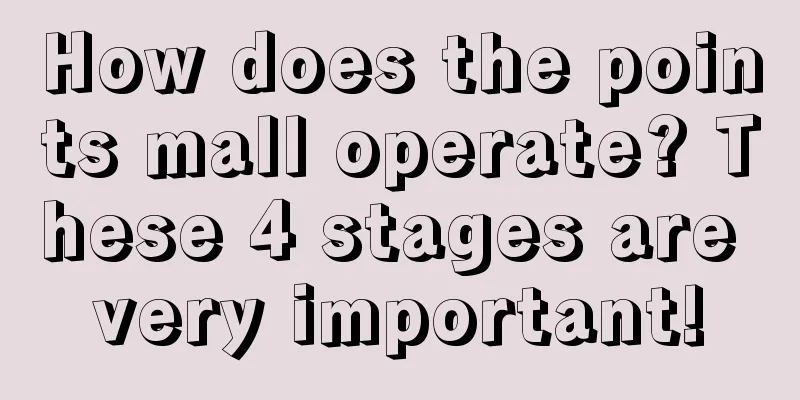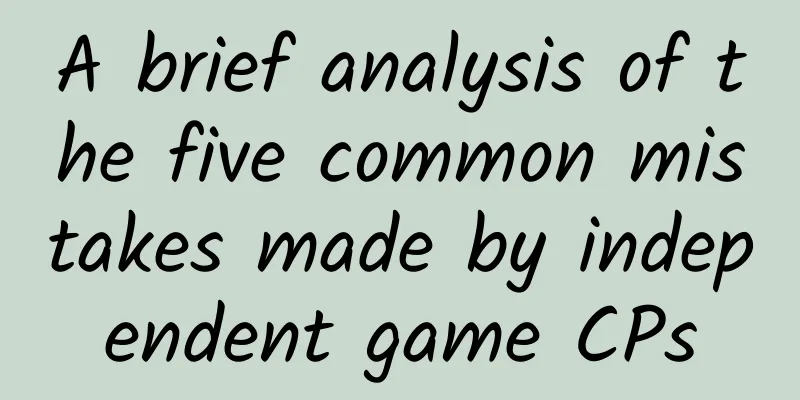How does the points mall operate? These 4 stages are very important!

|
When I first came into contact with the Points Mall, as a newbie I couldn’t help but search for articles related to the Points Mall on the Internet, but they were relatively fragmented and there was no systematic introduction. Therefore, based on the experience of operating the points mall in the past two years, I divide the points mall into four important stages; the duration of each stage depends on the actual situation of each company, and not all points malls will go through these four stages.
If the points mall is connected to a third party, it is not within the scope of discussion of this article. Phase 1: Improving Points AwarenessCore indicators: Points acquisition coverage rate, points consumption coverage rate Keywords : moderation During this stage, the points mall has the best time. Money is spent like water, and each month is more than the last. Have a bottle of Wai Wai Wai! The core goal of this stage is to allow more users to earn points and allow more users to spend points. Focusing on “Points Acquisition Coverage”
Focusing on “Points Consumption Coverage”
Points lottery: low threshold, added gimmick. For example, the original points lottery was worth 100 points, with hundreds of people participating every day, and 95% of users won the "Thank you for participating" lottery. Later, it was adjusted to 10 points for participation, 100% winning rate ("Thank you for participating" was adjusted to 1 point), and an iPhone grand prize was added (you know the winning rate). The number of daily participants increased 10 times, and the recycled points increased 5 times. Points treasure hunt: gambling psychology, small risks for big wins. Since the emergence of the 1 Yuan Treasure Hunt APP, the gambler mentality of users has been dramatically magnified. Every few days, people would hang banners at the entrance of the NetEase building. Eventually, the Supreme Court determined that the 1 Yuan Treasure Hunt was illegal. However, points are virtual currency that the platform rewards users for free and cannot be traded. They can only be used to redeem platform products, so it is not illegal. There are two directions for choosing products for the points treasure hunt. One is high value and convertible, such as gold bars, the latest iPhone, high-priced phone bills, etc. The characteristics are large number of participants and large number of points recovered. One is daily necessities with lower value, such as small phone bills, water cups and other daily necessities. The advantage is that the prize is drawn quickly and many issues can be run in a day. After the points treasure hunt went online, tens of thousands of people participated every day. Newbie gift pack: low threshold and strong guidance. When a new user (who has never spent points) enters the points mall, a pop-up window will appear to remind you that the novice gift package "only requires 10 points, 100% winning rate, and a cash prize of 888 yuan." After the launch of the novice gift package, the consumption ratio of new users entering the points mall every day increased from the original 20% to 60%. Phase 2: Prove the value of pointsCore indicators: promote activity, promote core behaviors, and stimulate paid conversions Keyword: value The core goal of the Points Mall, that is, the value of the Points Mall’s existence, is its value to the company. This value can be bringing in new users, promoting user activity, guiding the use of new features, or paid conversions. Find this value point and strengthen it. There is even a simplest method: the points will be stimulated based on the company's strategic focus and core business. The core reason why the points mall has become useless and its costs have been cut is that it does not reflect value - if a function or business cannot prove its own awesomeness (the boss's original words), it is only a matter of time before it is cut. The focus of this stage is to sort out and establish an indicator system, and the core is to obtain the approval of your leader/boss. Attract new customers Share and attract new customers. How many new users can the product bring after redeeming products in the points mall or sharing the winnings? Promote vitality 1. Continuous sign-in. How many users signed in consecutively? How many consecutive days of signing in? Compare the number of active days of this group of users before and after? What did the signed-in users do afterwards? 2. Jump from the points task page to the task execution page. How many users jump from the points task in the points mall to the task execution page? Paid conversions How many people redeemed coupons and discount vouchers, how many consumers consumed them, and what was the consumption ratio? How many orders does it bring to other businesses? How much revenue does it bring? Newbie Tasks Set up one-time points tasks for newly registered users and new functions. How many new users experience the core flow of the product? Are the activity/retention data of new users who have experienced the core process better than those of users who have not experienced it? For new features, how many users use it? How many users continue to use it? Phase 3: Control costsCore indicators: monthly cost, daily cost cap Keywords: User experience The vast majority of points malls stop here. They become trembling with fear after their bosses ask them to control costs, and the first thing they think about every day when they open their eyes is how to control costs. In the process of desperately controlling costs, the user experience will inevitably be reduced; after the user experience is reduced, the user's initiative/enthusiasm will be reduced, and the contribution value will further decrease. When the contribution value decreases, the boss will think that the points mall has no value and will continue to cut costs. This creates a vicious cycle: Cut costs → Poor user experience → Lower contribution value → Cut costs Poor user experience → Lower contribution value → Cut costs At this stage, cost control is important, but user experience is more important. Any changes must be notified to users in advance and there must be a transition period. Actively collect points Actively claiming points can, on the one hand, prove the value of points - I care about points, I have taken corresponding actions, and I actively come to the points mall to claim points. On the one hand, we should avoid random distribution. Giving points to users who don’t know about points and have no interest in points will increase costs. Secondly, when actively claiming points, you need to add a time limit for claiming them, such as valid within one week or one month. Increase the points ratio Avoid adjusting the points ratio directly on the original product. The correct approach is to remind users 3-5 days in advance that the original product is out of stock, then find a similar product of the same value, highlight its better quality, and finally increase the points required for redemption. Exchange restrictions Limits on redemption of a single product and a single user. It can be a daily limit or a monthly limit. Points are reset to zero. There are two ways to clear points:
Phase 4: Profit model explorationCore indicators: user payment amount, number of paying users , revenue Keywords: exploration How to get out of the vicious cycle of the points mall? Most operators first think of attracting sponsorship and cooperation, but this is far from enough and cannot form a self-circulating system for the points mall. A well-run points mall will inevitably reach this step, which is to explore a profit model. Here are a few reference directions: Points + Cash Exchange For example:
How to find suppliers with lower purchase prices? One way is to go to major online platforms, such as Taobao , JD.com , Suning, etc., and the other is offline factories. Brand customized products Needless to say, users cannot compare prices for customized products. As long as the quality is up to standard and the brand value is high, there will be more profit margins. QB, phone bills, memberships of major video websites If you go directly to third-party suppliers, the prices will be much lower than the official prices, and some can even be 50% off the official prices. The principle in this area is small profits but quick turnover, and large quantities will get better discounts. Directly sell products related to target users Find a third-party seller, who will be responsible for shipping and after-sales service and take a commission. Things to note at this stage: Since it involves paid user experience, you need to find a reliable product supplier to ensure timely delivery and after-sales service. The author of this article @Leone compiled and published by (Qinggua Media). Please indicate the author information and source when reprinting! Product promotion services: APP promotion services, information flow advertising, advertising platform |
>>: Be good! The AppStore charts have been blown up again!
Recommend
The most powerful "poison king" in the snake world is not on land, but in...
About tens of millions of years ago, the ancient ...
Let’s remember Qian Xuesen together today. This is the best way to commemorate him!
Beijing Time October 31, 2023 at 8:11 The return ...
Attract 150,000 fans in 10 days with 0 cost. It turns out that the AARRR model can be used in this way!
After reading many articles about the AARRR model...
How to optimize Google search ad keywords?
I believe everyone knows the importance of Google...
Home appliance repair advertising customer acquisition logic
1. Industry background The advantages of the home...
Why were dogs domesticated?
Recently I saw an interesting topic: If dogs rule...
Case analysis: Techniques for attracting new customers through paid content!
Since 2016, the concept of "micro-course&quo...
When connected to Wi-Fi, will the data flow still be "stolen"?
Many friends have always had a question: when the...
The 10 most worthwhile fruits and vegetables to eat in winter, many people miss them!
Some foods can provide a lot of nutrition with ju...
What are the advantages of the Webb telescope? The near-term mission has been determined. Will there be any shocking discoveries?
The Hubble Space Telescope (hereinafter referred ...
How to customize a photo of an African muscular man holding a sign, and how much does it cost for a photo shoot?
To customize the African mercenary sign , add our...
Tesla electric car, BMW M5 collide: the result is exaggerated
Video of a car accident involving an M5 high-perfo...
A big bet: A detailed analysis of the 2.3 billion "bet" between LeEco and "The Great Wall"
Two years after Coming Home, director Zhang Yimou...
How much does it cost to rent a server with bandwidth configuration for one million people?
The configuration of the server is closely relate...
Perl language entry to mastery video course
Perl language entry to mastery video course resou...









